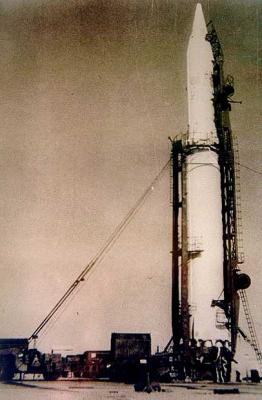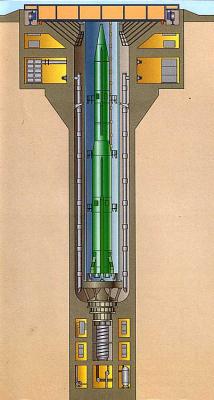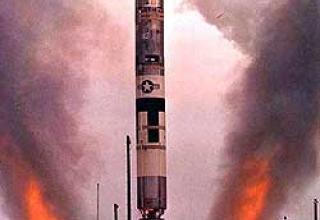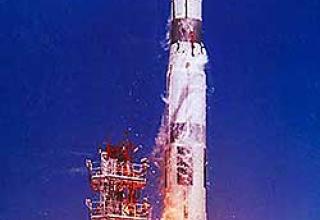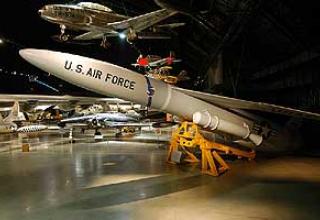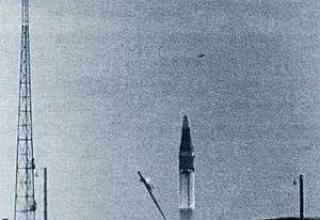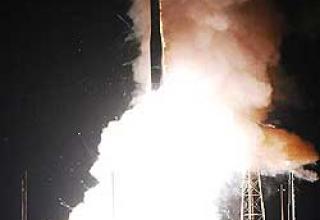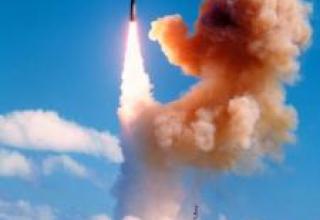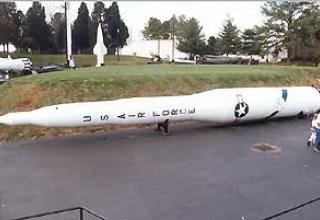On May 3, 1959, by a special joint resolution of the CPSU Central Committee and the Government, the team of the Design Bureau-586 (Yuzhnoye DO), Academician M.K. Yangel, was instructed to develop an intercontinental missile using high boiling fuel components. It was subsequently designated 8K64 . The need to develop this missile was determined by the low tactical and performance characteristics of the first Soviet R-7 ICBM.
In view of the aggravation of the international situation, the USSR government obliges the Design Bureau-586 to accelerate the development of the R-16 complex, launch flight tests at the end of 1960, and start mass production of missiles in 1962. In order to meet these extremely tight deadlines, the design teams followed the path of extensive use of 8K63 and 8K65 missiles. Initially 8K64 was supposed to be launched only from ground-based launchers.
For the development of the missile control system in Kharkiv there was established OKB-692. For the development of combustion chambers and gas generators of steering engines and power supply systems for marching engines on the test base of the OKB-586 was built a set of stands and an assembly and test case. For the engine design bureau of the OKB-586 there was built a laboratory and test case with stands for development of turbo-pump units. On the territory of 5 NIIP sites were allocated for the OKB-586, where the construction of the 8K64 missile launch position, assembly and test building and living area began. The development of the launch equipment was entrusted to Novokramatorsky Machine Building Plant, and later the Central Design Bureau-34 was involved in the creation of the Sheksna-V silo launch unit.
In order to combine production facilities and accelerate the transition to serial production of missiles OKB-586 and plant number 586 decided to transfer experimental production OKB to the plant. In August 1960, began firing stand tests of missile stages at the Research Institute-229. During the first test of the first stage from a powerful jet of the stand bounce tray was destroyed, but the launch was successful. In view of the lack of time for repairs, the commission decided to limit the tests to a single launch and, without repairing the tray, to begin testing on the Stage II test bench. After three Stage II tests, the missile was admitted to flight tests. Serial production of the 8K64 missiles began within the deadline set by the Government. In addition to plant No. 586, the missiles were manufactured by plant No. 166.
October 24, 1960 at 5 NIIP was preparing the rocket 8K64 for the first launch under the program LKI, which ended in disaster (as a result of a schematic error in the control system there was an unauthorized launch of engines II stage, which led to an explosion of the rocket at launch). 74 people were killed and 49 injured. Among the dead - the commander of the missile troops, Marshal M.Nedelin, a large group of leading specialists of the Design Bureau.
In February 1961, the first successful launch of the rocket took place, in February 1962 the launches under the LKI program from the ground start were completed. On November 1, 1961 the first three missile regiments in Nizhny Tagil and Yuria village, Kirov region, were prepared to take up combat duty.
Beginning from May 1960, there were carried out research and development work related to the implementation of the launch of a modified 8K64U rocket from the silo launcher. In January 1962 at the Baikonur range the first launch of the rocket from the control gear was held. February 5, 1963 began putting on combat duty the first missile regiment (Nizhny Tagil), armed with these ICBMs R-16U, and July 15 of the same year the complex R-16U was adopted by the Strategic Missile Forces.
Until 1965, 186 launchers of the R-16 and R-16U complexes were deployed. ICBMs of this type were in service until the mid-1970s. The last rockets of ground-based launchers were eliminated in 1977.
In the west, the missile was designated SS-7 "Saddler".
Composition:
The 8K64 missile was made in tandem with sequential separation of steps. The first stage consisted of an adapter to which the second stage was attached by means of four breaking bolts, an oxidizer tank, an instrument compartment, a fuel tank and a tail compartment with a power ring. The second stage, which served to accelerate the missile to a speed corresponding to a given range, had a similar design, but was made shorter and smaller in diameter.
The fuel tanks of the first stage and the "G" tank of the second stage were of a panel design, while the "O" tank of the second stage was made of sheet material using chemical milling. In order to ensure stable operation of the LRD, all the tanks were supercharged. The "G" tank of both stages is inflated with nitrogen, the "O" tank of stage II is inflated with air from balloons placed in the instrument compartment, and the "O" tank of stage I is inflated with a high-speed head of the oncoming air flow. Oscillating chambers of steering engines were used for the first time as controls.
Separation of stages of the rocket is carried out according to the following scheme: on command for the separation of stages is turned off the main engine and reduces the thrust of the steering engine I stage, after the launch of the steering engine II stage there is a rupture of the links between the stages and braking the body of the I stage by the brake PRD. The main engine of stage II is started after reaching a distance of 10-15 m between the stages. The head end is separated by braking the housing of stage II by the braking PRDs after switching off the main motor and then the stage II steering motor.
At the I stage of the rocket was installed main engine 8D712, which consists of three dual-chamber engines 8D515, unified with the rocket engines 8K65. A four-chamber 8D63U engine was used as a steering. The II stage installed the main two-chamber engine 8D713 and the steering four-chamber engine 8D64U. The fuel supply system in all engines is turbo-pumped with the main fuel combustion products feeding the turbines. All rocket engines operated on self-combustible fuel components: oxidizer AK-27I and fuel - asymmetric dimethylhydrazine (NDMG).
The missile could be equipped with two types of NPS from 3 to 6Mt. At maximum range, the so called "light" HF was used, while at intermediate and minimum ranges it was "heavy" with a charge of more powerful TNT equivalent. The HF cone shape with a hemispherical top was attached to the second stage housing using three tearing bolts. Its separation was carried out by braking the second stage when the brake gunpowder rocket engines were triggered. The maximum flight range, which ranged from 11,000 to 13,000 km, depended on the power of the head part. Along with improvement of combat missiles, thermonuclear charges continued to be improved in the USSR. Thus, during the flight tests of 8K64 missiles in 1961, it was prescribed to replace the charges in the head units of 8K64 and 8K65 missiles. In this regard, in 1962 there were developed unified MS, suitable for equipping both missiles. Later on, the principle of intra- and interspecific unification of units and products was widely used in various developments of Yuzhnoye SDO.
The 8K64 missile had a protected autonomous inertial control system. It included automatic machines for angular stabilization, stabilization of the center of mass, a system for regulating apparent speed, a system for simultaneous emptying of tanks, and a range control machine. For the first time a gyrostabilized ball bearing platform was used as a sensitive element of the SU on Soviet intercontinental missiles. The control system instruments were located in instrument compartments on the first and second stages. In preparation for launch, the missile was mounted on the launcher so that the stabilization plane was in the firing plane.
8K64U did not differ from 8K64U structurally. To ensure the launch from the control panel was changed automation of the first stage propulsion system. On the missile body were made platforms for the installation of rods, fixing its position in the guides of the mine launcher. Fuel tanks began to be inflated with nitrogen.
BRK R-16 became the base for the creation of a group of intercontinental missiles of the Strategic Missile Forces. The ground-based launch complex included a combat position with two launchers, one common command post and a rocket fuel storage. The missile was launched after it was placed on the launch table, fueled with rocket fuel components and compressed gases, and aiming operations were performed. All these operations took quite a long time. In order to reduce it, four degrees of technical readiness were introduced, characterized by a certain time before a possible launch, which was necessary for a number of prelaunch and launch operations. The 8K64 ICBM could be on high alert after 30 minutes.
The 8K64U was deployed in much smaller numbers because it took more time to build mine complexes (such as Sheksna) than to bring a RK with ground-based boosters into service. At each starting position, there were three BCPs placed in line about 100 meters apart, an underground command post, fuel component storage facilities, and other facilities. The method of starting from the mine was gas-dynamic with its own engines. There are rods installed on the rocket for driving in the mine on rails, as well as for depreciation. Mine protective roof - flat, sliding on rails. The missile was placed inside on a special turning device with docked refueling system communications. For ballistic missile with 8K64U ICBMs three alert levels were installed. Launch time from full alert was 18 min.
Characteristics:
| General characteristics | |
| Maximum firing range, km | 11000-13000 |
| Firing accuracy, km | ±10 |
| Launch time from full alert, mines. | 18 |
| Warranty period of fueled rocket, 24 hours | 30 |
| 8K64 missile | |
| Launching weight of the rocket, tc | 140.6 - 141.2 |
| Weight of fuel components, tc | 130 |
| Length, m | 30.44 - 34.3 |
| Maximum housing diameter, m | 3 |
| Hull diameter HF, m | 2 |
| Length HF, m | 4.5 |
| Remote Control Features | |
| The pull of the 1st stage (on the ground/in the void), ps: - main - helmsman |
226.5/266 28.85/33 |
| Specific impulse of stage I remote control (on the ground/in the void), p. 2: - main - helmsman |
246/289 235/273 |
| Circuit puller of II stage (in the emptiness), ps: - main - helmsman |
90 4.92 |
| Specific impulse remote control II stage (in the void), s: - main - helmsman |
293 250 |
Testing:
When forming missile units and formations armed with the R-16 and R-9A missile systems, the experience of forming and building the country's first facility designed for the intercontinental missile system R-7 was used.
Like all the missiles of the first generation, these ICBMs could not stay in the fueled state for a long time. They were stored in shelters or mines with empty tanks and took considerable time to be ready for launch. Soviet ICBMs were inferior to U.S. missiles in terms of the time they were on alert. The low survivability of Soviet missile systems made it virtually impossible to launch a retaliatory strike. In addition, as early as 1964 it became clear that this missile was morally outdated.
In May 1963, at 5 NIIP demonstrated group launch from the mines of three missiles 8K64U (triplet) for the leaders of the socialist commonwealth.
The total number of launches was 307, successful launches 91%.
The launch of one of the 8K64 missiles in June 1966 was observed at Baikonur range by French President Ch. de Gaulle, who was in the USSR on an official visit.
Sources:
- "Призваны временем. Ракеты и космические аппараты конструкторского бюро "Южное"./ Под общей редакцией С.Н.Конюхова/. Д.: Арт-Пресс, 2004,-232с.
- "КБ специального машиностроения: От артиллерийских систем до стартовых комплексов" (под редакцией Ушакова В.С.) .СПб, 2004.
- Колесников С.Г. "Стратегическое ракетно-ядерное оружие" 1996г.
- Бельтюков В.Л., Окунев С.Ю., Чернов П.В. Из истории ракетных войск стратегического назначения // Война и оружие. Новые исследования и материалы. Труды Девятой Международной научно-практической конференции, 15-17 мая 2019 г. В двух частях. Часть 1. – СПб.: ФГБУ “ВИМАИВиВС” МО РФ, 2019. – С. 140.
- http://space.hobby.ru/yangel.html
- http://rau-rostov.narod.ru/01/rvsn-mbr/r-16.htm
